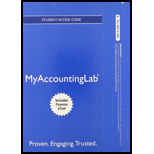
a.
To identify: The type of activity using following abbreviations in the given statement:
1. Operating activity—addition to net income (O+)
2. Operating activity—subtraction from net income (O–)
3. Financing activity (F)
4. Investing activity (I)
5. Activity that is not on the statement of cash flows (NA)
b.
To identify: The type of activity using following abbreviations in the given statement:
1. Operating activity—addition to net income (O+)
2. Operating activity—subtraction from net income (O–)
3. Financing activity (F)
4. Investing activity (I)
5. Activity that is not on the statement of cash flows (NA)
c.
To identify: The type of activity using following abbreviations in the given statement:
1. Operating activity—addition to net income (O+)
2. Operating activity—subtraction from net income (O–)
3. Financing activity (F)
4. Investing activity (I)
5. Activity that is not on the statement of cash flows (NA)
d.
To identify: The type of activity using following abbreviations in the given statement:
1. Operating activity—addition to net income (O+)
2. Operating activity—subtraction from net income (O–)
3. Financing activity (F)
4. Investing activity (I)
5. Activity that is not on the statement of cash flows (NA)
e.
To identify: The type of activity using following abbreviations in the given statement:
1. Operating activity—addition to net income (O+)
2. Operating activity—subtraction from net income (O–)
3. Financing activity (F)
4. Investing activity (I)
5. Activity that is not on the statement of cash flows (NA)
f.
To identify: The type of activity using following abbreviations in the given statement:
1. Operating activity—addition to net income (O+)
2. Operating activity—subtraction from net income (O–)
3. Financing activity (F)
4. Investing activity (I)
5. Activity that is not on the statement of cash flows (NA)
g.
To identify: The type of activity using following abbreviations in the given statement:
1. Operating activity—addition to net income (O+)
2. Operating activity—subtraction from net income (O–)
3. Financing activity (F)
4. Investing activity (I)
5. Activity that is not on the statement of cash flows (NA)
h.
To identify: The type of activity using following abbreviations in the given statement:
1. Operating activity—addition to net income (O+)
2. Operating activity—subtraction from net income (O–)
3. Financing activity (F)
4. Investing activity (I)
5. Activity that is not on the statement of cash flows (NA)
i.
To identify: The type of activity using following abbreviations in the given statement:
1. Operating activity—addition to net income (O+)
2. Operating activity—subtraction from net income (O–)
3. Financing activity (F)
4. Investing activity (I)
5. Activity that is not on the statement of cash flows (NA)
j.
To identify: The type of activity using following abbreviations in the given statement:
1. Operating activity—addition to net income (O+)
2. Operating activity—subtraction from net income (O–)
3. Financing activity (F)
4. Investing activity (I)
5. Activity that is not on the statement of cash flows (NA)
k.
To identify: The type of activity using following abbreviations in the given statement:
1. Operating activity—addition to net income (O+)
2. Operating activity—subtraction from net income (O–)
3. Financing activity (F)
4. Investing activity (I)
5. Activity that is not on the statement of cash flows (NA)
l.
To identify: The type of activity using following abbreviations in the given statement:
1. Operating activity—addition to net income (O+)
2. Operating activity—subtraction from net income (O–)
3. Financing activity (F)
4. Investing activity (I)
5. Activity that is not on the statement of cash flows (NA)
m.
To identify: The type of activity using following abbreviations in the given statement:
1. Operating activity—addition to net income (O+)
2. Operating activity—subtraction from net income (O–)
3. Financing activity (F)
4. Investing activity (I)
5. Activity that is not on the statement of cash flows (NA)
n.
To identify: The type of activity using following abbreviations in the given statement:
1. Operating activity—addition to net income (O+)
2. Operating activity—subtraction from net income (O–)
3. Financing activity (F)
4. Investing activity (I)
5. Activity that is not on the statement of cash flows (NA)
Want to see the full answer?
Check out a sample textbook solution
Chapter 13 Solutions
NEW MyLab Accounting with Pearson eText -- Access Card -- for Managerial Accounting
- Direction: Study the given data below and compute for (1) the cash generated/used in financing activities, (2) the net change in cash for the year, and (3) prepare the CFS for the year. Learning is Fun Company has presented the following in order to aid the account in preparing CFS during the month. Net income: P200, 000 Depreciation expense: P25, 000 Gain on sale on property and equipment: P100. 000 Decrease in trade and other receivables: P 70, 000 Purchase of property and equipment: P200, 000 Payment of loan from bank: P150, 000 Compute for the cash generated/used in financing activities. Based on the given above, compute for the net change in cash for the year.arrow_forwardWrite a research paper on the following learning objectives. OBJECTIVES: Explain the difference between accounting value and market value Discuss the difference between accounting income and cash flow Asses the difference between average and marginal tax rates Evaluate how to determine a firm's cash flow from its financial statementsarrow_forwardS1-9. (Learning Objective 4: Identify appropriate financial statement) Suppose you areanalyzing the financial statements of Corley, Inc. Identify each item with its appropriatefinancial statement, using the following abbreviations: Income statement (I), Statement ofretained earnings (R), Balance sheet (B), and Statement of cash flows (C). Three items appearon two financial statements, and one item shows up on three statements.a. Salary expenseb. Dividendsc. Accounts payabled. Net incomee. Common stockf. Inventoryg. Interest revenueh. Cashi. Retained earningsj. Long-term debtk. Increase or decrease in cashl. Net cash provided by operatingactivitiesm. Sales revenuen. Net cash used for financingactivitiesarrow_forward
 Financial Accounting: The Impact on Decision Make...AccountingISBN:9781305654174Author:Gary A. Porter, Curtis L. NortonPublisher:Cengage Learning
Financial Accounting: The Impact on Decision Make...AccountingISBN:9781305654174Author:Gary A. Porter, Curtis L. NortonPublisher:Cengage Learning


